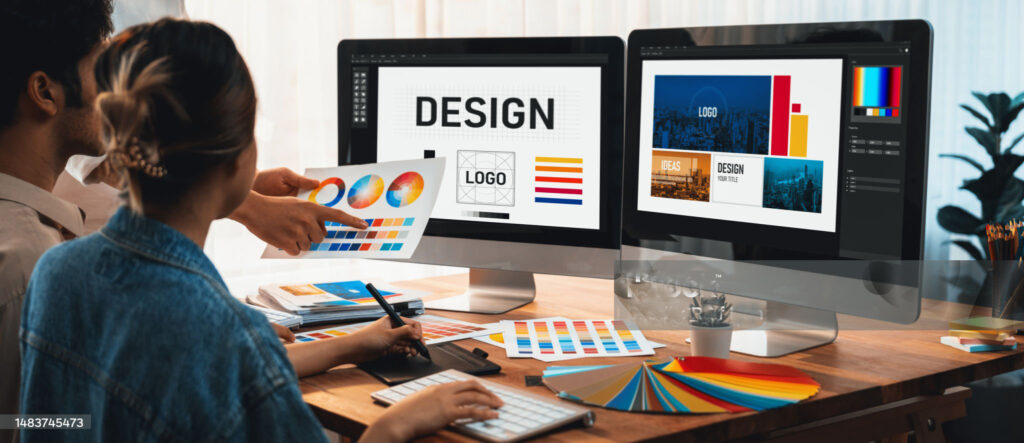What is the Ideal Balance between Investing in a Website Design And Other Aspects of Digital Marketing? : Expert Insights

Finding the right balance between website design and other digital marketing aspects can be tricky. Both are crucial for business success.
An eye-catching website can attract visitors, but it’s not enough on its own. Digital marketing efforts, such as SEO, social media, and content creation, drive traffic to your site. Without these, even the best-designed website may go unnoticed. Striking a balance is key.
You need a site that not only looks good but also ranks well and engages visitors. In this blog, we will explore how to achieve that perfect harmony, ensuring your website design and digital marketing efforts work together for maximum impact.

The Role Of Website Design
The role of website design is vital in digital marketing. A well-designed website can attract and retain visitors. It can also boost your brand’s credibility. Investing in website design can greatly impact your overall marketing success. But how much should you invest in website design compared to other aspects of digital marketing?
First Impressions
First impressions matter. Your website is often the first interaction potential customers have with your brand. A clean and professional design builds trust. It makes your brand look credible. A poorly designed website can drive visitors away. It can harm your brand’s reputation. Invest in good design to make a strong first impression.
User Experience
User experience is crucial for keeping visitors on your site. A good design ensures easy navigation. Users should find what they need quickly. This reduces bounce rates and increases engagement. A well-designed website enhances user satisfaction. It encourages them to stay longer and explore more. This can lead to higher conversion rates.

Importance Of Digital Marketing
Digital marketing is crucial for any business today. It helps in reaching a wider audience. Without it, a business may struggle to grow. Digital marketing includes various strategies. These strategies help in promoting your products or services online. Investing in digital marketing can lead to higher sales and better brand recognition.
Brand Awareness
Brand awareness is essential for any business. It helps people recognize your brand. Digital marketing plays a key role here. Through social media, SEO, and other tactics, you can increase your brand’s visibility. The more people know your brand, the more trust you build. This trust leads to customer loyalty and repeat business.
Lead Generation
Lead generation is vital for business growth. Digital marketing helps in capturing leads. Techniques like email marketing and pay-per-click ads can attract potential customers. These leads can then be nurtured into paying customers. A steady flow of leads means a steady flow of revenue. Investing in digital marketing ensures you always have leads to work with.
Allocating Budget: Design Vs. Marketing
Allocating budget between website design and other digital marketing aspects is crucial. A website’s design impacts user experience and conversions. Marketing drives traffic and engagement. Finding the right balance ensures effective use of resources. This section explores how to allocate your budget efficiently.
Assessing Priorities
Identify your business goals. Are you aiming for brand awareness or sales? If first impressions matter, invest in design. An appealing website retains visitors. Poor design can drive potential customers away. On the other hand, a well-designed site needs traffic. This is where marketing comes in.
Roi Considerations
Consider the return on investment (ROI). Website design is a one-time cost. It sets the stage for future marketing efforts. Digital marketing, however, involves ongoing expenses. Measure the impact of each. Which brings in more leads? Which converts better? Track metrics like bounce rates and conversion rates. These insights help in budget allocation.

Combining Design And Seo
Combining design and SEO is essential for a successful digital presence. A well-designed website attracts visitors. SEO ensures they find it. The challenge is to balance both. Prioritize user experience while making your site search-engine friendly.
Seo-friendly Design
An SEO-friendly design enhances user experience and boosts search rankings. Start with a clean and responsive layout. Mobile-friendly websites rank higher. Use clear navigation. Search engines and users prefer easy-to-use websites. Fast loading times improve user satisfaction and SEO performance. Optimize images and reduce unnecessary scripts.
Include relevant keywords in your design elements. Title tags, headers, and meta descriptions should contain target keywords. These elements help search engines understand your content. Use descriptive URLs. They are easier for users and search engines to read.
Content Integration
Content is the backbone of SEO. Integrate high-quality content within your design. Use relevant keywords naturally in your content. Avoid keyword stuffing. It can harm your SEO efforts. Create informative and engaging content. Valuable content keeps visitors on your site longer.
Incorporate blogs, articles, and multimedia. These elements enhance user experience. They also provide fresh content for search engines to index. Use internal linking. Connect related content within your site. It helps users navigate and boosts SEO.
Ensure your design supports easy content updates. Content management systems (CMS) like WordPress make this easy. Regular updates signal to search engines that your site is active and relevant.
Balancing Aesthetics And Functionality
Balancing aesthetics and functionality in website design is crucial for digital success. A visually appealing website attracts visitors, but it must also be user-friendly. Finding the right balance ensures a positive user experience and effective digital marketing.
Visual Appeal
A website’s visual appeal matters a lot. It creates the first impression for visitors. Use a clean layout, appealing color schemes, and high-quality images. Consistent branding helps build trust and credibility. A visually pleasing site keeps visitors engaged and encourages them to explore more.
Usability
Usability is equally important as visual appeal. A site must be easy to navigate. Clear menus, intuitive design, and fast loading times are essential. Mobile responsiveness is also a key factor. A user-friendly site enhances the user experience and boosts conversions.
Leveraging Social Media
Balancing your investment between website design and other digital marketing aspects is key. One crucial area to focus on is leveraging social media. Social media can drive traffic, build brand awareness, and foster customer relationships. It’s a powerful tool, but it needs a well-thought-out strategy to be effective.
Engagement Strategies
Engagement is vital on social media. It’s not just about posting content. It’s about creating conversations and building relationships. Consider these strategies:
- Ask questions: Get your audience involved by asking for their opinions.
- Use visuals: Images and videos catch the eye more than text.
- Be consistent: Regular posts keep your audience engaged and expecting more.
Remember, engagement can boost your reach. It helps your content appear in more feeds.
Cross-promotion
Cross-promotion is a smart way to maximize your social media presence. It involves sharing your content across different platforms. Here are some methods:
- Share website content: Post links to your blog or product pages on social media.
- Collaborate: Partner with influencers or other brands to reach new audiences.
- Repurpose content: Turn a blog post into an infographic or video for social media.
Cross-promotion can bring more visitors to your website. It can also enhance your brand’s visibility.
Measuring Success
Measuring success is crucial in digital marketing. It helps determine if your strategies work. Balancing investment in website design and other marketing aspects is essential. But how do you measure success effectively? Let’s explore some key tools and metrics.
Analytics Tools
Analytics tools are vital for tracking your website’s performance. Google Analytics is a popular choice. It provides insights into user behavior and traffic sources. You can see which pages are most visited. Another useful tool is SEMrush. It helps analyze your competitors’ strategies. It also offers data on keywords and backlinks.
Another tool to consider is Ahrefs. It focuses on SEO performance. It shows your website’s ranking and backlink profile. These tools help you understand your website’s strengths and weaknesses. They guide you in making informed decisions.
Performance Metrics
Performance metrics help evaluate your digital marketing efforts. One key metric is conversion rate. It shows the percentage of visitors who take action. Actions can include signing up for a newsletter or making a purchase. A high conversion rate indicates effective marketing.
Another important metric is bounce rate. It shows the percentage of visitors who leave your site quickly. A high bounce rate suggests that your website design or content may need improvement. Time on site is also crucial. It measures how long visitors stay on your website. Longer visits often mean engaging content.
Click-through rate (CTR) is another valuable metric. It shows how many people click on your ads or links. A high CTR means your marketing messages resonate with your audience. These metrics help you measure your success and identify areas for improvement.
Expert Tips And Best Practices
Balancing investment between website design and other digital marketing aspects can be tricky. Both are crucial for online success. Below are expert tips and best practices to help you achieve the ideal balance. Learn from industry insights and case studies to make informed decisions.
Industry Insights
Experts recommend allocating a significant portion of your budget to website design. A well-designed site enhances user experience and builds trust.
- Responsive Design: Ensure your website works on all devices. This boosts user engagement.
- SEO-Friendly: A website optimized for search engines attracts more organic traffic.
- Fast Loading Times: Slow websites lose visitors. Prioritize speed.
Investing in these elements ensures your site stands out. It also supports other digital marketing efforts like SEO and PPC.
Case Studies
Let’s look at some case studies to understand the impact of balancing website design with other digital marketing aspects.
| Company | Strategy | Outcome |
|---|---|---|
| Company A | Invested heavily in website design and SEO | Increased organic traffic by 50% |
| Company B | Focused on PPC and minimal design updates | Short-term traffic boost, but low retention |
| Company C | Balanced investment in design, SEO, and content | Steady growth and high user engagement |
These cases show that a balanced approach yields the best results. Investing in both website design and other digital marketing aspects is key.
Remember to regularly review and adjust your strategy. This ensures you stay ahead in the competitive digital landscape.
Frequently Asked Questions
How Important Is Website Design For Digital Marketing?
Website design is crucial for digital marketing. It impacts user experience, engagement, and conversions. A well-designed website can attract and retain visitors, making it essential for success.
Should I Invest More In Website Design Or Seo?
Balancing both is key. Website design enhances user experience, while SEO drives organic traffic. Invest wisely in both for optimal results.
Can A Good Design Improve My Site’s Ranking?
Yes, a good design improves ranking. User-friendly layouts and fast load times boost SEO, enhancing your site’s visibility.
How Does Website Design Affect User Engagement?
Website design directly affects user engagement. A visually appealing, easy-to-navigate site keeps visitors longer, reducing bounce rates.
Conclusion
Finding the right balance between website design and digital marketing is crucial. Both aspects play vital roles in online success. Invest wisely in a user-friendly website. Ensure it is visually appealing and easy to navigate. Don’t neglect other marketing efforts like SEO, content creation, and social media.
These strategies drive traffic and engagement. Evaluate your budget and goals carefully. Allocate resources to areas with the highest return on investment. A well-balanced approach ensures overall digital success. Prioritize and plan for long-term benefits.



